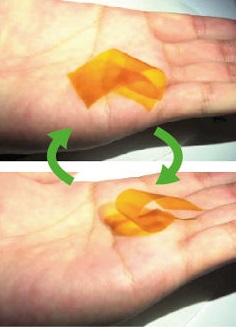Using AI to control energy for indoor agriculture
30 September 2024
Published online 22 June 2015
Researchers produce thin films of a material that is able to move in response to water and light.

© Panče Naumov/NYU-AD
Many organisms, such as bacterial spores and germinating seeds, show a dramatic response to water in their surroundings. Taking a leaf out of their books, researchers have developed many synthetic polymers that are humidity-driven actuators—they can convert the potential energy in humidity gradients to a mechanical response.
However, the application of such materials has been limited by their inherently slow response times.
To get around this, Panče Naumov, a chemist from New York University in Abu Dhabi, and his team went to the drawing table. They developed a new material; a hybrid between agarose, a polysugar with a high capacity to hold water, and an azo-benzene derivative that has a chemical response to ultraviolet light and confers added robustness1.
When a thin film of the material is exposed to a moist surface, the distal side expands less than the proximal one, causing the film to curl upwards. Adsorption and desorption occur at different rates, which causes this curling to occur in a defined periodic manner, with up to 150 repetitions of the cycle per minute, resulting in effectual motion.
The material can do mechanical work equivalent to carrying a load 85 times its own weight, and is extremely sensitive to humidity gradients. Simply placing it on the palm of the hand caused the film to flit around rapidly and ceaselessly.
Additionally, the photoresponsiveness of the material allows the external use of UV light to push the system into rapid action. In this way, a parallel on/off switching mechanism that can kick start the humidity-driven mechanical response allows the material to get around the slow response times in actuation.
doi:10.1038/nmiddleeast.2015.104
Stay connected: